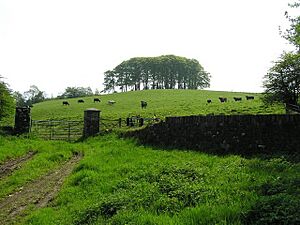Favor Royal Demesne facts for kids
Favor Royal Demesne, also spelled Favour Royal, is a special place in County Tyrone, Northern Ireland. It's a type of area called a townland, which is like a small district or neighborhood. This townland is located near the border with the Republic of Ireland. It covers a large area, about 670 acres, which is roughly the size of 500 football fields!
Contents
Discovering Favor Royal Demesne
Favor Royal Demesne is named after a historic estate, also called Favour Royal. An estate like this is a large piece of land with a big house, often owned by one family for a long time. This particular estate was given to a person named Sir Thomas Ridgeway way back in 1613 by the King.
What is a Demesne?
A "demesne" (pronounced de-MAIN) is a fancy word for the land kept by a lord or landowner for their own use, rather than rented out to others. It usually includes the main house, gardens, and surrounding lands. Favor Royal Demesne is so important that it's listed on a special register for historic parks and gardens.
The Big House at Favor Royal
At the heart of the demesne is a large house. This house was built in 1823, so it's nearly 200 years old! Sadly, it's currently "derelict," which means it's abandoned and falling apart. Even so, it's still considered a very important historic building.
People of the Past
We can learn a little about the people who lived in Favor Royal Demesne a long time ago. In 1841, there were 105 people living there in 21 houses. Ten years later, in 1851, the population had slightly decreased to 95 people living in 20 houses. This gives us a glimpse into how many families called this place home in the past.
Ancient Forts: The Ringforts
Favor Royal Demesne is also home to some very old and interesting historical sites. There are two "scheduled historic monuments" located here. A scheduled monument is a site that is protected by law because of its historical importance.
These monuments are both "bivallate raths."
- A rath (pronounced RAH-th) is an ancient circular fort. It was built by people living in Ireland many centuries ago, often during the Iron Age or early medieval period.
- "Bivallate" means that these raths have two sets of protective banks and ditches around them, making them even stronger.
These raths show us that people were living and building in this area thousands of years ago! They are important clues about how people lived, worked, and defended themselves in ancient times.


